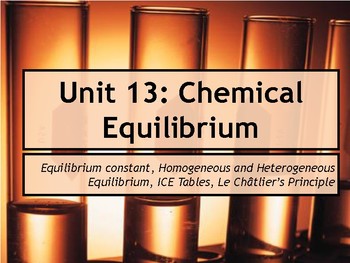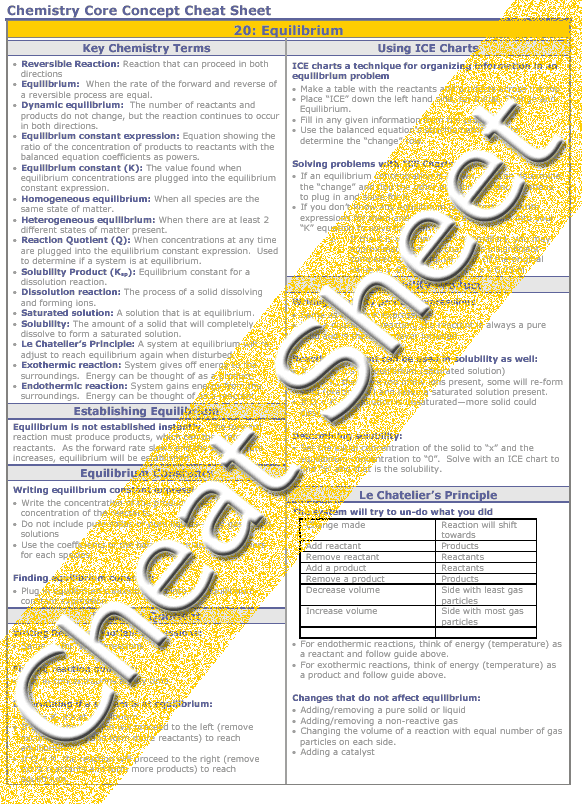
- Ap Chem Equilibrium Frq Answers
- Ap Chem Equilibrium Frq


Ap Chem Equilibrium Frq Answers
You are given a box containing NH 3, N 2, and H 2 at equilibrium at 1000°C. Analysis of the contents shows that the concentration of NH 3 is 0.102 mole/liter, N 2 is 1.03 moles/liter, and H 2 is 1.62 moles/liter. When 0.40 mole of SO 2 and 0.60 mole of O 2 are placed in an evacuated 1.00–liter flask, the reaction represented below occurs. 2SO 2 (g) + O 2 (g) ↔ 2SO 3 (g). After the reactants and the product reach equilibrium and the initial temperature is restored, the flask is found to contain 0.30 mole of SO 3.

Chapter 13: Chemical Equilibrium > G. Le Chatelier's Principle- Le Chatlier's principle explains the kinetics of equilibrium reactions
- The Principle states: 'if a change is imposed on a system at equilibrium, the position of the equilibrium will shift in a direction that tends to reduce that change'
- this means that, the equilibrium will shift away from the side of the reaction on which a change is induced
- a reaction will always shift in a direction to be closer to the concentration at equilibrium
- For example: increased concentration of reactants will shift equilibrium in the direction of the forward reaction (toward the products) and visa versa
- Pressure can also effect a reaction
- there are three ways to manipulate a reaction using pressure:
- add or remove a gaseous reactant or product
- add an inert gas
- change the volume of the container
- adding a gaseous product will shift the reaction towards the reactants because of increase in concentration of products and increased the pressure of the container which would force the gaseous molecules to react more frequently. Removing gaseous product would shift the reaction to create more of that gaseous product because the reverse reaction could not occur.
- adding an inert gas would not react with any of the molecules in the reaction but would increase the pressure, which would force the side of the reaction with more gaseous molecules to collide more frequently therefore shifting equilibrium away from the side with more gaseous reactants.
- changing the volume of the container would change the pressure. Increasing the volume would cause the side with gaseous reactants to react less frequently, therefore shifting the reaction towards the side with more gaseous reactants. Decreasing the volume would increase the pressure, causing the side with more gaseous reactants to collide more frequently, shift in the reaction to the side with less gaseous molecules
- 'the system responds by reducing its own volume'
- as explained by the ideal gas law, at constant temperature and pressure, the volume of the gas is directly proportional to the number of moles present. :
- V= (RT/P)n V∝n
- A change in temperature will change the positioin of equilibrium because it changes the equilibrium constant ( as opposed to the previous ways to change the position of equilibrium which do not change the value of K)
- if the reaction is endothermic, equilibrium will shift right
- if the reaction ifs exothermic, equilibrium will shift left
1) Arsenic can be extracted from its ores by first reacting the ore with oxygen (called roasting) to form solid As4O6, which is then reduced to carbon: As4O6(s) + 6C(s)↔ As4(g) + 6CO(g) Predict the direction of the shift of the equilibrium position in response to each of the following changes in conditions. a) Addition of carbon monoxide b) Addition or removal of carbon or tetraarsenic hexoxide (As4O6) c) Removal of gaseous arsenic (As4) Solution a) When the concentration of a substance increases, the equilibrium shifts away from that substances. Therefore the equilibrium will shift left. b) The concentrations of pure solids don't affect equilibrium. Therefore there will be no shift in equilibrium. c) When the concentration of a substance decreases, the equilibrium will shift towards the substance. Therefore the equilibrium will shift right. 2) Predict the shift in equilibrium position that will occur for each of the following processes when the volume is reduced. a) The preparation of liquid phosphorus trichloride by the reaction: P4(s) + 6Cl2(g)↔4PCl3(l) b) The preparation of gaseous phosphorous pentachlordie according to the equation: PCl3(g) + Cl2(g)↔PCl5(g) c) The reactionof phosphorous trichloride with ammonia: PCl3(g) + 3NH3(g)↔P(NH2)3(g) + 3HCl(g) Solution a) Decreasing the volume does not effect solids or liquids, only gases. The equilibrium will shift to the side with less gaseous molecules. Since the left side has 6 gaseous molecules and the right side none, the equilibrium will shift right. b)Since the product side has one gaseous molecule and the reactan side has two, the equilibrium will shift right. c) Since both sides have four gaseous molecules there will be no shift in equilibrium position. |
|
Ap Chem Equilibrium Frq
','url':'http://www.youtube.com/watch?v=cHAjhM3y3ds','width':854,'height':480,'providerName':'YouTube','thumbnailUrl':'http://i1.ytimg.com/vi/cHAjhM3y3ds/hqdefault.jpg','resolvedBy':'youtube'}'>
In this video Paul Andersen explains how equilibrium is achieved in a reversible reaction. When the rate of the forward reaction is equal to the rate of the reverse reaction the system is at equilibrium. Graphical analysis of equilibrium is included along with a walkthrough of several calculations.

Bozemanscience Resources

Equilibrium Concept Map
Equilibrium Slideshow






